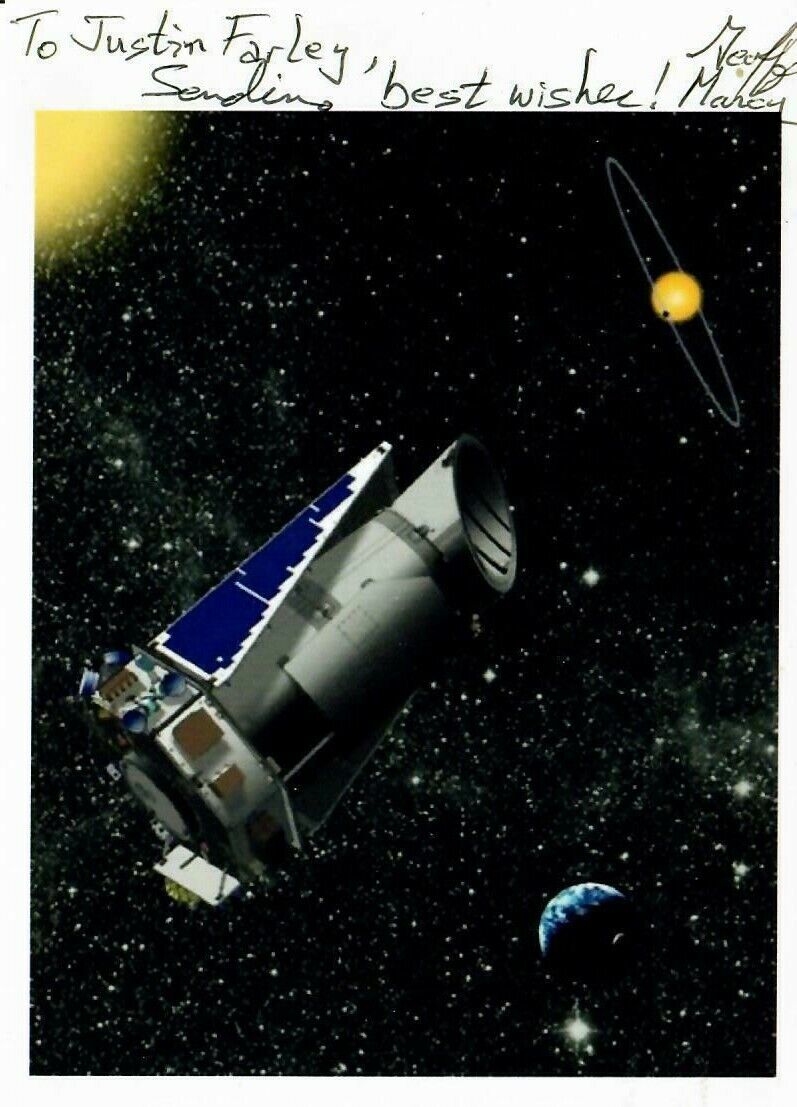"Exoplanets" Geoffrey Marcy Hand Signed 4X6 Color Photo For Sale

When you click on links to various merchants on this site and make a purchase, this can result in this site earning a commission. Affiliate programs and affiliations include, but are not limited to, the eBay Partner Network.
"Exoplanets" Geoffrey Marcy Hand Signed 4X6 Color Photo:
$69.99
Up for sale "Exoplanets" Geoffrey Marcy Hand Signed 4X6 Color Photo.
ES-3183
Geoffrey William Marcy (born
September 29, 1954) is an American astronomer. He is one of the pioneers and leaders in the
discovery and characterization of exoplanets. Marcy was Professor of Astronomy at the University of California,
Berkeley and an Adjunct Professor of Physics and Astronomy
at San Francisco State
University before stepping down in October 2015. His colleagues
in the Berkeley Astronomy Department forced him to resign after allegations of
sexual harassment. Marcy and his research
teams are recognized for discovering many extrasolar planets, including 70 out of the first 100
known exoplanets and also the first planetary system around a
Sun-like star, Upsilon Andromedae. Marcy
was a co-Investigator on the NASA Kepler missionthat discovered over 4000 exoplanets. Early
collaborators include R. Paul Butler, Debra Fischer and Steven S. Vogt. Later collaborators include Jason Wright,
Andrew Howard, Katie Peek, John Johnson, Erik Petigura, Lauren Weiss, Lea
Hirsch and the Kepler Science Team. Marcy graduated from Granada Hills High School in
Granada Hills, California, in 1972. He graduated with a Bachelor of Arts summa cum laude with a double major in physics and astronomy from the University
of California, Los Angeles in 1976. He then completed a
doctorate in astronomy in 1982 at the University
of California, Santa Cruz,[ with much of his work done at Lick Observatory. Marcy has held teaching and research
positions, first at the Carnegie Institution of
Washington (then the Mt. Wilson and Las Campanas Observatories)
as a Carnegie Fellow from 1982 to 1984. He then worked as an Associate
Professor of Physics and Astronomy from 1984 to 1996 and then as a
Distinguished University Professor from 1997 to 1999 at the San Francisco State
University. Marcy was a Professor of Astronomy and the Watson and
Marilyn Alberts Chair for SETI at the University of California, Berkeley from
1999 through 2015. In 2015, he resigned after being found in violation of UC
Berkeley's sexual harassment policy. From 2000 to 2012, he was the Director of
UC Berkeley's Center for Integrative Planetary Science. Marcy was also one of
the project leaders of the Breakthrough Initiatives that
will search for intelligent life in the universe, using large radio and optical
telescopes. Marcy and his team confirmed Michel Mayor and Didier
Queloz's discovery of the first extrasolar planet orbiting a
Sun-like star—51 Pegasi b. Two
months later, Marcy and his team followed this confirmation with the
announcement of the discovery of two additional planets around 47 Ursa Majoris and
70 Virginis. Other achievements include discovering the first multiple
planet system around a star similar to our own (Upsilon around
another star, simultaneously with David Charbonneau and Timothy Brown (HD209458b), the first extrasolar planet orbiting beyond
5 AU (55 Cancri d), and the first Neptune-sized planets (Gliese 436b and 55 Cancri e). Marcy was a Co-Investigator of the NASA Kepler
mission[10] that discovered over 4000
exoplanets, most being smaller than 4 times the size of Earth. His team, led by
Erik Petigura and Andrew Howard, showed that approximately 20% of Sun-like
stars have a planet of 1–2 times the size of Earth and receive incident stellar
light within a factor of 4 of the light the Earth receives from the Sun, making
them warm planets, many of which accommodate liquid water.
More
recently, in May 2017, Marcy was involved in studies related to laser light
emissions from stars, as a way of detecting technology-related
signals from an alien civilization.
The study included Tabby's Star (KIC
8462852), an oddly dimming star in which its unusual starlight fluctuations may
be the result of interference by an artificial megastructure, such as a Dyson swarm, made by such
a civilization. No evidence was found for technology-related signals from
Tabby's Star in the studies.

Related Items:
"Exoplanets" Geoffrey Marcy Hand Signed 4X6 Color Photo
$48.99

